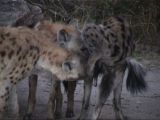Yes, testosterone is the male sex hormone that makes males muscular, aggressive and horny. But what happens when the female is a 'package' of testosterone? Not only 'fully loaded', but with higher amounts than males have?
This is the case of the spotted hyena. In fact, the clitoris of the spotted hyena grows to a pseudopenis, the vulva is fused, and the clitoris is used for urination, mating (it contracts for mating, the opening widening to allow the penetration from the male's penis) and giving birth.
To complicate it all, the females also possess a fake scrotum made by the enlarged joined vulva and pseudo-testes filled with fatty tissue. You can imagine the surprise of some of the first explorers of Africa at the beginning of the XIXth century when they found that their caged "male" hyenas gave birth!
For a long time, the species was believed to be hermaphrodite! In fact, only the gland's shape makes the difference between a penis and a clitoris in spotted hyenas. The erection of the penis or clitoris (which is voluntary in both sexes) is certainly a display of submission in both male and female spotted hyena and the clitoris plays a high social role in their clans.
The subordinate individuals lick the clitoris of a higher ranked female as a sign of submission. The clitoris of the dominant female will be licked by all the other females and males (which are inferior to any female). When females lick each other's clitorises, this is a greeting or an affective behavior that strengthens links between individuals. Usually, females won't lick males' penises (sorry, guys, no oral sex!), as they are clearly subordinate, the higher ranked male is inferior to the lower ranked female.
As it is impossible to penetrate without the female's cooperation, female spotted hyenas have full control of the mating. That's why female hyenas avoid incestuous mating by forcing male relatives to look in other groups for sex, as found by a new research, and it is for the first time revealed in mammals.
The research led by Oliver H?ner at the Leibniz Institute for Zoo and Wildlife Research in Berlin, Germany, took 10 years and was made on 8 groups of spotted hyenas living in Ngorongoro Crater (Tanzania), the world's largest intact volcanic caldera.
The study combined dispersal of male hyenas DNA and field observations of over 400 individuals. It appeared that young female hyenas prefer mating with males immigrated from other clans, or with males born after them (which at least could not have the same father). Older females mated just with immigrants, and the more fortunate were those that had courted them for several years.
Due to this sexual behavior of the females, 89 % of young males change their clans when reaching sexual maturity. "This pattern is the result of females following an instinctual mating rule that prevents incestuous encounters. This rule requires males to have entered the group after the females were born. The older females also have an additional rule: They don't particularly like new, young males that they don't know well," said H?ner.
Inbred offspring are known to have less genetic diversity, fact that makes them more vulnerable to infections, genetic diseases and are generally less fit and weaker.
Inbreeding is especially detrimental for the females as they dedicate 15 to 18 months to a litter of 1-3 cubes, while males are not involved in the raising of the young. "Females invest so much more in their young. If males breed with a close relative, they don't lose very much because they have other females they can produce offspring with." H?ner said.
As rape is impossible in the hyena society (where the female is larger, more aggressive with that nasty penis-clitoris), males have no other choice than leaving the clan. But female mating choice could explain the male dispersal patterns observed in many other mammals. "In the vast majority of mammals the typical pattern is that males disperse and females stay, or that males disperse over a greater distance than females. We think that in many group-living mammals where females have a choice of different mates, it's very difficult for females to recognize their fathers. The female mate choice we found here is likely to play an important role in other species, primates included.", H?ner said.
"The new research probably could only have been conducted in Ngorongoro Crater, where so many clans live in close proximity to one another and where visibility for observers is excellent. The research supports a hypothesis many of us have favored for many years-that female mate choice is all-important in this species.", said spotted hyena expert Kay Holekamp from Michigan State University.

 14 DAY TRIAL //
14 DAY TRIAL // 
